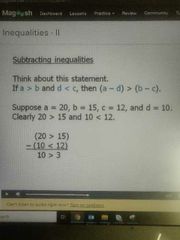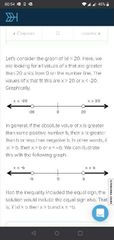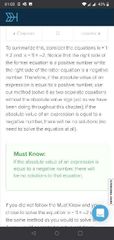![]()
![]()
![]()
Use LEFT and RIGHT arrow keys to navigate between flashcards;
Use UP and DOWN arrow keys to flip the card;
H to show hint;
A reads text to speech;
16 Cards in this Set
- Front
- Back
|
If XY < 0 then what is X and y? |
X and y have both different signs. One is positive and one is negative. |
|
|
X^2 < X |
If this the case then 0 < X < 1 i.e. X is positive but between 0 and 1. |
|
|
XY > 0, then what is X and y |
Both X and y have same signs. Either positive or both negative. |
|
|
When you multiply and divide an inequality by negative number, the inequality sign flips? |
True. |
|
|
you can add two inequalities together if the inequality direction in each of these is identical. Otherwise you can not. |
True. |
|
|
You can subtract two inequalities if the inequality direction in each of these is in opposite direction. Subtraction can't be done if inequality in each is in same direction.
The resultant or the difference follows the inequality sign of the initial one. |

True. |
|
|
In order to add inequalities, the individual inequalities must have the inequality sign in the same direction. |
True |
|
|
We should never divide an inequality by a variable if we don't know the exact sign of the variable as dividing by positive variable won't reverse the inequality but dividing by a negative will. |
True. |
|
|
If two variables' ranges are given, such that, theirs an inequality sign in these ranges, then the maximum and minimum value of their product can be evaluated after evaluating four quantities of AC, AD, BC, BD. The biggest of these will be maximum value of product and the smallest will be the minimum value of the product |

|
|
|
If two absolute values are equal, then it must be true that the expressions within the absolute value bars are either equal or opposite. It is only necessary to calculate one equation with opposite absolute value while determine value of the variable. |

|
|
|
Absolute value of a + b (the sum of two numbers) will always be less than or equal to the absolute value of a plus the absolute value of b. In the case, both sides are equal i.e. | a + b | = |a| + |b| then a and b will always have the same sign or either of these quantities will be zero. |

True. |
|
|
Absolute value of a - b (the difference of two numbers) will always be greater than or equal to the absolute value of a minus the absolute value of b. In the case, both sides are equal i.e. | a - b | = |a| - |b| then a and b will always have the same sign along with the first quantity's absolute value will be greater than the second ones OR either the second quantity will be zero. |

True |
|
|
If the absolute value and inequality occur together: for any number b, if |X|< b then the solution would be -b < X < b. It will be -b > X > b for when |X| > b |

The photo shows the number for the second case as first one is pretty basic |
|
|
If the absolute value of an expression equals to a negative number don't solve such Equations, as there would be no solutions. The expressions in absolute value equal to a positive number has to be solved only. |

|
|
|
If an absolute value equation has variables on both sides and we are unable to determine whether there is a negative number or not (as we don't solve in case of negative numbers) always solve the equation and then check the solutions to see if they Satisfy the equation. |
Always check for externaous roots. |
|
|
Ix+ Y | <= lxl + IYI |
True For example, if x = 10 and y = 2, then Ix+ YI = |12 | = 12 = lxl + lyl; and if x = 10 and y = -2, then Ix+ yl = | 8 | = 8 < 12 = lxl + IYI |

